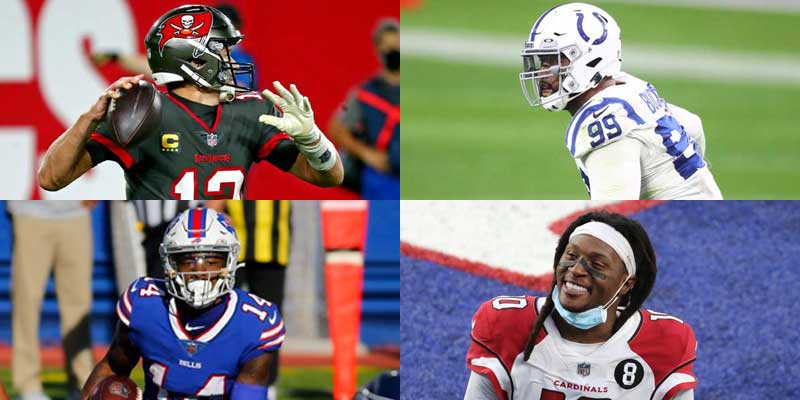Analysis
2/15/21
6 min min read
Who Were the Winners and Losers of Last Year's Offseason?


Everyone and their mom can talk about how much they like or hate a deal at the time it happens, but it’s only with the benefit of hindsight that one can truly evaluate how successful a move was. J.J. Watt was booed by Texans fans when he was drafted, while the “Dream Team” Eagles never took off. Here’s a look back at how the most notable free agent signings, trades and extensions from last year worked out.
Obvious Wins
Tom Brady brought a Super Bowl to Tampa Bay, while Patrick Mahomes remains the best player on the planet. Travis Kelce is setting records at the tight end position, while Jalen Ramsey and James Bradberry are Pro Bowlers shutting down the top receivers each week. Joey Bosa led all edge rushers in pressure rate, while Myles Garrett dominates off his side. None of these success stories are even that close to debate without serious nitpicking.
There’s certainly a lot of talk about the value of running backs, but high-level extensions for Alvin Kamara, Dalvin Cook and Derrick Henry all look good so far. Each made the Pro Bowl and put up astounding numbers, whether you prefer Kamara’s 1,688 total yards, Cook’s 1,557 rush yards and 0.22 missed tackles forced per attempt, or Henry successfully breaking the 2,000-yard barrier.
Among trades, the Jets didn’t look good for shipping out the malcontent Jamal Adams, but bringing back three early picks and Bradley McDougald fits their timeline much better, giving them flexibility to jump around the draft and attack their needs.
The Cardinals may not have jumpstarted their offense as much as hoped, but it’s by no means due to DeAndre Hopkins. Finishing second among WRs with 1,407 receiving yards was well worth two non-first-round picks and an aging RB, as well as a flexible two-year extension.
DeForest Buckner’s move to Indianapolis went as well as could be hoped for the Colts. The first-time All-Pro put up 9.5 sacks of his own and propelled Indy to the second-best run defense in the league. Behind a run-and-stop-the-run philosophy, the Colts are in position to compete even without a quarterback.
Both sides of the Stefon Diggs deal are ecstatic. The Bills got everything they hoped for in the league leader in most categories who opened up the field for new MVP candidate Josh Allen, and the Vikings nailed the only premier draft pick in the deal in Justin Jefferson, a rookie Pro Bowler and direct replacement for Diggs, yet much cheaper.
Seemingly Wins
The Colts may not have managed the deep playoff run they were hoping for, but Philip Rivers brought leadership and above-average play to a young team, all while sustaining the Colts’ nearly-$70 million in cap space this offseason.
Tre’Davious White made the Pro Bowl as a top star for the Bills but ranked only 36th among CBs for completion percentage allowed as the Buffalo defense took a step back. There’s still a lot of promise, but it wasn’t the clear-cut home run that other deals were.
Pro Bowler Chris Jones falls into a similar category in Kansas City, making the Pro Bowl and putting up a 14.8% pressure rate that was third among IDLs, but the Chiefs run defense remains middling at best and Jones’ $20 million AAV won’t help find support.
The Texans had no choice but to pay out for Laremy Tunsil, with a 3-year deal worth $22 million AAV with $50 million guaranteed, and he performed well, making the Pro Bowl and allowing only a 3.6% pressure rate (14th among OTs). He’ll have to keep it up to justify his climbing $19.4 million cap hit, third among all offensive linemen.
Cam Heyward was an extension that went under-the-radar at signing, but produced for the Steelers with Heyward adding his fourth consecutive Pro Bowl selection. As one of the older players on this list (32 at the start of next season), the four-year deal could start to look bad soon, especially considering Heyward’s four-year low of only 4 sacks in 2020.
The Christian McCaffrey extension might be a surprise in this tier when considering he missed almost all of the 2020 season, but he was actually more elusive in his short time on the field, forcing a missed tackle nearly every 4 carries, which would be second-best in the NFL and a career high if he had enough carries to qualify. McCaffrey had never missed an NFL game before, so Carolina will chalk it up to bad luck and try to get him back healthy for next year.
A trio of wide receiver deals for Keenan Allen, Amari Cooper and Cooper Kupp all produced mostly how expected. Allen and Cooper both put up strong numbers with new QBs, while Kupp managed the second-most yards after contact of all receivers (551). The Chargers, Cowboys and Rams all tended to spread the ball around last season, so these deals won’t necessarily age well, but they’ll be happy for now.
The Jaguars look smart for moving on from Yannick Ngakoue, as he’s hit his third team in a year. They will need to hit on their extracted 2021 second-round pick to really make this a home run. The Seattle side of the Jamal Adams trade is also remembered fondly when considering Adams’ record-setting (for a safety) 9.5 sacks and league-leading 28.8% pressure rate, but he still needs to settle in against the pass.
Could Go Either Way
Carolina gets credit for negotiating a short-term, cheaper deal with Teddy Bridgewater, but a lackluster finish down the stretch leads to reports that the team is looking to move on. The team might not have their quarterback of the future, but they have a capable bridge on an affordable contract.
The Kenny Clark extension in Green Bay isn’t an albatross yet, but a three-year low with an 8.6% pressure rate (42nd) isn’t exactly what the team was hoping for with the 4-year deal paying $17.5 million AAV. Clark is still only 25, but the team will hope this was an outlier year.
Robert Woods was the other of the Rams’ big-budget extensions, but he was outperformed by teammate Cooper Kupp despite playing significantly more snaps. With a longer, more expensive deal (despite fewer guarantees), Woods will hope to build a quick rapport with new Rams QB Matthew Stafford.
Minnesota certainly won’t be happy with their end of the Yannick Ngakoue trade, but their grade is salvaged by a midseason trade to Baltimore that recouped almost all of their value. In all, Minnesota got a half-season and four sacks in exchange for dropping from the second to the third round and losing some spots in the fifth. More teams than would freely admit would take that deal.
The 49ers sent away DeForest Buckner instead of paying him, but a year later he’s an All-Pro and San Francisco is an injury-ravaged team with more questions than answers. At the very least, the first-round pick they received turned into Javon Kinlaw, who has shown some promise and could save this grade.
Seemingly Losses
There’s really no such thing as an obvious loss a year after a mega-deal, unless a player has been outright released or traded for pennies, but these deals are trending in the wrong direction.
Byron Jones and Darius Slay have two of the top-six 2021 cap hits in the NFL for CBs, but both took a step backwards with their new teams despite recent Pro Bowl appearances. Jones allowed a middling 62.1% completion rate (66th among CBs), but allowing a horrific 110.2 passer rating is not how to make good on over $54 million in guarantees. Slay was supposed to be the answer to the Eagles’ secondary problems, but ranked 121st among corners for completion rate allowed, his career worst by over 10 percentage points.
A pair of former Los Angeles Rams pass rushers in Robert Quinn and Dante Fowler Jr. both secured significant contracts, but neither consistently got to the QB, ranking 56th and 91st respectively in pressure rate with only 5 combined sacks. Quinn’s contract in particular still has 4 years remaining.
Arik Armstead was the beneficiary of Buckner’s departure, receiving a 5-year deal with $17 million AAV, but had a career-low 10.4% pressure rate with only 3.5 sacks. As one of the few 49ers to start all 16 games and with a significant cap hit after 2021, he simply has to produce more.
The Lions retooled their offensive line with a variety of moves, the largest being OT Taylor Decker. Although his cap hit remains low for 2021, it explodes to over $17 million for the subsequent three years, and Decker’s 24th-ranked pressure rate allowed (among OTs) simply won’t cut it in improving the NFL’s last-rated offense.
Finally, the Texans still look bad for dealing DeAndre Hopkins. David Johnson had exactly one game over 100 yards rushing and one game over 100 yards receiving, finishing with under 700 rushing yards and his fewest receiving yards per game ever. The only premier pick exchanged, a second-rounder that turned into DL Ross Blacklock, is not nearly enough to offset the imbalance between the 1,400-yard Hopkins and Johnson, even if Blacklock did play a solid rotational role throughout the year.
After a 2020 season that was unprecedented in every sense of the word, the number of deals that still look good with a year of hindsight is fairly amazing. Only a handful of mega-contracts and blockbuster trades can soundly fall into the “do not repeat” pile, but several more are enthusiastic successes. Of course, another year of hindsight could change everything.








